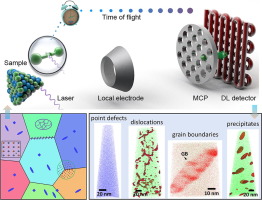当前位置:
X-MOL 学术
›
Mater. Today
›
论文详情
Our official English website, www.x-mol.net, welcomes your
feedback! (Note: you will need to create a separate account there.)
Revealing nano-chemistry at lattice defects in thermoelectric materials using atom probe tomography
Materials Today ( IF 21.1 ) Pub Date : 2020-01-01 , DOI: 10.1016/j.mattod.2019.11.010 Yuan Yu , Chongjian Zhou , Siyuan Zhang , Min Zhu , Matthias Wuttig , Christina Scheu , Dierk Raabe , Gerald Jeffrey Snyder , Baptiste Gault , Oana Cojocaru-Mirédin
Materials Today ( IF 21.1 ) Pub Date : 2020-01-01 , DOI: 10.1016/j.mattod.2019.11.010 Yuan Yu , Chongjian Zhou , Siyuan Zhang , Min Zhu , Matthias Wuttig , Christina Scheu , Dierk Raabe , Gerald Jeffrey Snyder , Baptiste Gault , Oana Cojocaru-Mirédin

|
Abstract The population of all non-equilibrium lattice defects in materials is referred to as microstructure. Examples are point defects such as substitutional and interstitial atoms, and vacancies; line defects such as dislocations; planar defects such as interfaces and stacking faults; or mesoscopic defects such as second-phase precipitates. These types of lattice imperfections are usually described in terms of their structural features, breaking the periodicity of the otherwise regular crystalline structure. Recent analytical probing at the nanoscale has revealed that their chemical features are likewise important and characteristic. The structure of the defects as well as their individual chemical composition, that is their chemical decoration state, which results from elemental partitioning with the adjacent matrix, can significantly influence the electrical and thermal transport properties of thermoelectric materials. The emergence of atom probe tomography (APT) has now made routinely accessible the mapping of three-dimensional chemical composition with sub-nanometer spatial accuracy and elemental sensitivity in the range of tens of ppm. Here, we review APT-based investigations and results related to the local chemical decoration states of various types of lattice defects in thermoelectric materials. APT allows to better understand the interplay between thermoelectric properties and microstructural features, extending the concept of defect engineering to the field of segregation engineering so as to guide the rational design of high-performance thermoelectric materials.
中文翻译:

使用原子探针断层扫描揭示热电材料晶格缺陷的纳米化学
摘要 材料中所有非平衡晶格缺陷的总体称为微观结构。例子是点缺陷,如置换和间隙原子,以及空位;位错等线缺陷;平面缺陷,如界面和堆垛层错;或细观缺陷,如第二相沉淀物。这些类型的晶格缺陷通常根据它们的结构特征来描述,打破了原本规则的晶体结构的周期性。最近在纳米尺度上的分析探测表明,它们的化学特征同样重要且具有特征性。缺陷的结构以及它们各自的化学成分,即它们的化学装饰状态,这是由与相邻基体的元素分配引起的,可以显着影响热电材料的电和热传输特性。原子探针断层扫描 (APT) 的出现现在使得以亚纳米级空间精度和数十 ppm 范围内的元素灵敏度绘制三维化学成分图成为常规。在这里,我们回顾了基于 APT 的研究和与热电材料中各种类型晶格缺陷的局部化学装饰状态相关的结果。APT 可以更好地理解热电特性和微观结构特征之间的相互作用,将缺陷工程的概念扩展到分离工程领域,从而指导高性能热电材料的合理设计。原子探针断层扫描 (APT) 的出现现在使得以亚纳米级空间精度和数十 ppm 范围内的元素灵敏度绘制三维化学成分图成为常规。在这里,我们回顾了基于 APT 的研究和与热电材料中各种类型晶格缺陷的局部化学装饰状态相关的结果。APT 可以更好地理解热电特性和微观结构特征之间的相互作用,将缺陷工程的概念扩展到分离工程领域,从而指导高性能热电材料的合理设计。原子探针断层扫描 (APT) 的出现现在使得以亚纳米级空间精度和数十 ppm 范围内的元素灵敏度绘制三维化学成分图成为常规。在这里,我们回顾了基于 APT 的研究和与热电材料中各种类型晶格缺陷的局部化学装饰状态相关的结果。APT 可以更好地理解热电特性和微观结构特征之间的相互作用,将缺陷工程的概念扩展到分离工程领域,从而指导高性能热电材料的合理设计。
更新日期:2020-01-01
中文翻译:

使用原子探针断层扫描揭示热电材料晶格缺陷的纳米化学
摘要 材料中所有非平衡晶格缺陷的总体称为微观结构。例子是点缺陷,如置换和间隙原子,以及空位;位错等线缺陷;平面缺陷,如界面和堆垛层错;或细观缺陷,如第二相沉淀物。这些类型的晶格缺陷通常根据它们的结构特征来描述,打破了原本规则的晶体结构的周期性。最近在纳米尺度上的分析探测表明,它们的化学特征同样重要且具有特征性。缺陷的结构以及它们各自的化学成分,即它们的化学装饰状态,这是由与相邻基体的元素分配引起的,可以显着影响热电材料的电和热传输特性。原子探针断层扫描 (APT) 的出现现在使得以亚纳米级空间精度和数十 ppm 范围内的元素灵敏度绘制三维化学成分图成为常规。在这里,我们回顾了基于 APT 的研究和与热电材料中各种类型晶格缺陷的局部化学装饰状态相关的结果。APT 可以更好地理解热电特性和微观结构特征之间的相互作用,将缺陷工程的概念扩展到分离工程领域,从而指导高性能热电材料的合理设计。原子探针断层扫描 (APT) 的出现现在使得以亚纳米级空间精度和数十 ppm 范围内的元素灵敏度绘制三维化学成分图成为常规。在这里,我们回顾了基于 APT 的研究和与热电材料中各种类型晶格缺陷的局部化学装饰状态相关的结果。APT 可以更好地理解热电特性和微观结构特征之间的相互作用,将缺陷工程的概念扩展到分离工程领域,从而指导高性能热电材料的合理设计。原子探针断层扫描 (APT) 的出现现在使得以亚纳米级空间精度和数十 ppm 范围内的元素灵敏度绘制三维化学成分图成为常规。在这里,我们回顾了基于 APT 的研究和与热电材料中各种类型晶格缺陷的局部化学装饰状态相关的结果。APT 可以更好地理解热电特性和微观结构特征之间的相互作用,将缺陷工程的概念扩展到分离工程领域,从而指导高性能热电材料的合理设计。











































 京公网安备 11010802027423号
京公网安备 11010802027423号